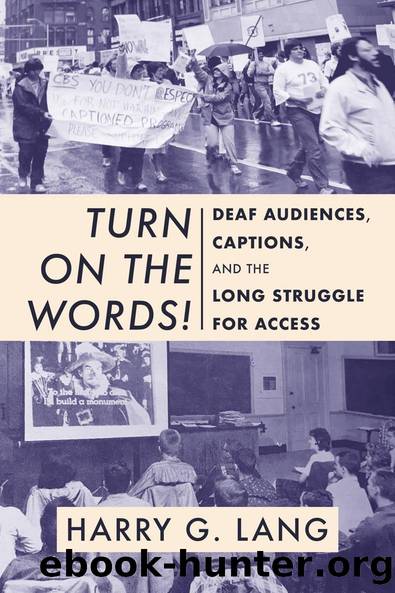Turn on the Words! by Harry G. Lang

Author:Harry G. Lang [Lang, Harry G.]
Language: eng
Format: epub
ISBN: 9781944838928
Google: iZ9vzgEACAAJ
Publisher: Gallaudet University Press
Published: 2021-01-15T02:48:15+00:00
Ernest E. Hairston meets Nancy Reagan at a Recordings for the Blind Awards Ceremony. Image courtesy of Ernest E. Hairston.
This was a time when the winds of change were blowing. One catalyst for that change was the ADA, with its emphasis on the broad term disabilities and on full and equal opportunity for all citizens. Until 1990, deafness was the only disability addressed by the captioned films program. Also significant were the 1990 Amendments (PL 101-476) and the renaming of the 1975 Education for All Handicapped Children Act (EHA) legislation as IDEA. These changes focused on individuals with special needs and their preparation for the world of work and college, and affected the whole of the MSCF branch of the Department of Education. Among the provisions were added authorized training in instructional and assistive technology services aimed at dramatically increasing the number of technology projects. In serving a larger audience, captioning, in particular, gained ground in becoming a universal technology. Within a few years, the technology would be regulated by both the Television Decoder Circuitry Act of 1990 and the Telecommunication Act of 1996 and enforced by the US FCC.3
Both former and current CFV leaders were paying close attention to the potential impact of the new laws. IDEA improved on the EHA, providing a âfree appropriate public education which emphasizes special education and related services designed to meet their unique needs,â amended by PL 99-457 (EHA Amendments of 1986). Mac Norwood indicated two years before IDEA was passed that the âname of the game today is educational servicesâ and that the role in the governmentâs MSCF branch included research in technology related to âhandicappedâ children. Norwood viewed as a top priority the utilization of television as a means of bringing deaf people further into the mainstream of the general population.
Len Novick caught an important omission in the 1990 amendments: âI was astonished to discover that the underlying language supporting captioning contained reference to âfilmâ only, with no mention of captioned television, which by that time had existed as a service for almost a decade.â As Novick worked with congressional staffers, what became PL 101-476 was edited to firmly establish authorization for federal support of captioned television.
âLen Novick, âCaptioned Films for the Deaf: My Perspective,â
Described and Captioned Media Program, https://dcmp.org/learn/375-captioned-films-for-the-deaf-my-perspective
Download
This site does not store any files on its server. We only index and link to content provided by other sites. Please contact the content providers to delete copyright contents if any and email us, we'll remove relevant links or contents immediately.
| American National Standards Institute (ANSI) Publications | Architecture |
| History | Measurements |
| Patents & Inventions | Research |
Whiskies Galore by Ian Buxton(41704)
Introduction to Aircraft Design (Cambridge Aerospace Series) by John P. Fielding(33008)
Small Unmanned Fixed-wing Aircraft Design by Andrew J. Keane Andras Sobester James P. Scanlan & András Sóbester & James P. Scanlan(32676)
Craft Beer for the Homebrewer by Michael Agnew(18068)
Turbulence by E. J. Noyes(7884)
The Complete Stick Figure Physics Tutorials by Allen Sarah(7253)
Kaplan MCAT General Chemistry Review by Kaplan(6806)
The Thirst by Nesbo Jo(6744)
Bad Blood by John Carreyrou(6464)
Modelling of Convective Heat and Mass Transfer in Rotating Flows by Igor V. Shevchuk(6345)
Learning SQL by Alan Beaulieu(6148)
Weapons of Math Destruction by Cathy O'Neil(6069)
Man-made Catastrophes and Risk Information Concealment by Dmitry Chernov & Didier Sornette(5862)
Digital Minimalism by Cal Newport;(5570)
Life 3.0: Being Human in the Age of Artificial Intelligence by Tegmark Max(5391)
iGen by Jean M. Twenge(5290)
Secrets of Antigravity Propulsion: Tesla, UFOs, and Classified Aerospace Technology by Ph.D. Paul A. Laviolette(5229)
Design of Trajectory Optimization Approach for Space Maneuver Vehicle Skip Entry Problems by Runqi Chai & Al Savvaris & Antonios Tsourdos & Senchun Chai(4946)
Electronic Devices & Circuits by Jacob Millman & Christos C. Halkias(4857)
